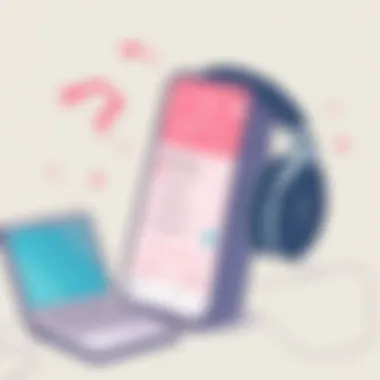Enhancing Your Offline Music Experience


Intro
In a world where streaming services have become the lifeblood of music consumption, the art of enjoying music offline often gets left in the dust. Yet, there are many situations where having access to music without an internet connection is not just a luxury, but a necessity. Whether you're on a long road trip, hiking in the wilderness, or simply trying to cut down on data usage, optimizing your offline music experience is crucial.
This guide explores not only the best strategies for downloading free music safely and legally, but also delves into the world of MP3 players—devices that can bring your offline music library to life. You might think of MP3 players as relics of the past, but they’re far from obsolete. They offer a practical solution for accessing your favorite tunes without the baggage of constant connectivity.
As we walk through this guide, we will touch on various tactics for downloading music, comparing several models of MP3 players on the market, and providing expert tips for creating an unrivaled listening experience. In the end, the goal is simple: to elevate your enjoyment of music, ensuring you never have to be without your favorite tracks, no matter where life takes you.
Let’s dive into the specifics, starting with a look at the various options for downloading music, ensuring you stay on the right side of the law while you do it.
Understanding Free Music Downloads
Free music downloads have become an increasingly relevant subject for audio enthusiasts. As listeners seek ways to enjoy their favorite tunes without racking up hefty subscription fees, understanding how to navigate the world of free music downloads safely and legally can dramatically enhance one's offline music experience. This segment will illuminate the essence of free music downloads, analyzing their definitions and exploring the implications of legality and safe sourcing, which ultimately solidify the listener’s journey towards enjoying music without constraints.
Defining Free Music Downloads
At its core, free music downloads refer to audio files that can be obtained without a fee directly through various platforms. These downloads can range from officially released tracks by independent artists to recordings available under open licenses, making it an attractive option for many. One of the driving forces behind this trend is the cultural shift away from traditional music purchasing methods. Fans no longer feel obligated to purchase entire albums when they are more inclined to curate their playlists with specific songs.
Legality of Free Music Downloads
When discussing free music downloads, legality is an indispensable factor. Many people are quick to download tracks freely from various sources, but the legality can vary widely.
Copyright Considerations
Copyright laws protect artists, ensuring they receive fair compensation for their work. This legal framework complicates the landscape for free music downloads. Many downloads available online might infringe copyright, leading users unknowingly into murky waters. It’s vital to understand that not all free downloads are legitimate; opting for content that respects copyright laws isn’t just ethical but also safeguards against potential legal repercussions.
Creative Commons Licenses
Creative Commons licenses offer an alternative that’s more transparent for users looking to download music legally. These licenses provide a way for artists to keep their rights while granting permission for others to use their work under specific conditions. This framework opens up a treasure trove of tracks for listeners eager to explore a diverse soundscape without feeling like they might be stepping on someone's toes. It allows creators to control how their music gets shared while encouraging its diffusion throughout the community.
Safe Sources for Free Music
Knowing where to find free music is just as important as understanding the legalities. Getting music from reputable and safe platforms ensures that there are fewer risks involved, both legally and in terms of the quality of the downloads.
Notable Platforms
Several noteworthy platforms cater to those seeking free music. Websites like Free Music Archive and Jamendo offer a wide array of tracks under Creative Commons licenses, enabling users to explore realms of music often unheard. These sites specialize in access to a treasure of independent artists and several genres that might not be readily available on mainstream platforms. Not only do these sources provide quality tunes, but they also foster up-and-coming artists, granting them a chance to shine.
Emerging Trends
In the fast-paced music industry, emerging trends continuously reshape the way free music is distributed. From live streamed events featuring artists who offer exclusive downloads to unique partnerships between brands and musicians, the landscape of free music is ever-evolving. Digital platforms have successfully integrated diverse forms of media and sound into a single experience, leading to a more immersive and interactive consumption method for music lovers. The convergence of social media and music serves as a breeding ground for alternative distribution channels, implying that the realm of free music downloads is likely to continue evolving.
"Understanding where to download free music legally not just enriches your experience but also appreciates the art itself."
By laying a foundation of knowledge in these areas, the music fan can be well-equipped to seek, download, and enjoy music responsibly and efficiently.
Exploring MP3 Players
Understanding the various types of MP3 players is essential for optimizing your offline music experience. As music lovers, we often find ourselves torn between options. Whether it's purely for convenience or we seek superior sound quality, the right MP3 player can make all the difference in how we enjoy our music. Choosing the right device isn't just about brand name; it also comes down to your personal listening habits and preferences.
Types of MP3 Players
Dedicated Music Players
Dedicated music players serve a specific purpose: to deliver music in the most focused manner possible. Their singular focus on audio quality usually comes with high-performance audio chips, optimized software, and extensive audio format support. This means you’re often looking at devices that can handle lossless files and other premium formats—great if you care about audio fidelity.
One of their standout characteristics is the physical interface, which often includes real buttons for controls rather than relying heavily on touch screens that can be finicky when on the go. This tends to make them more user-friendly in certain situations, like jogging or navigating crowded spaces. But they don’t come without downsides; dedicated players can sometimes lack the versatility of smartphones and might feel redundant for someone who just wants their tunes on a multi-function device.
Some dedicated players also offer unique features like high-resolution playback, but these can come at a premium price. For the audiophile, these players are a valuable investment. They often provide a richer listening experience without the distractions of calls and notifications.
Smartphones as MP3 Players
Smartphones have become our go-to devices for music because of one simple fact: they’re everything-in-one. With the right apps, your phone can serve equally well for music playback, apps for finding free downloads, and organization features to manage your library. The advantage here lies in portability and flexibility. A smartphone not only holds your music; it allows you to stream, record, and share with ease.


However, there’s a trade-off to consider. While many smartphones have decent sound quality, they may not match dedicated players in audio fidelity due to the compression of formats and limitations in built-in DACs (Digital-to-Analog Converters). You can enhance your experience with external DACs or high-quality headphones, but the average user may not go this extra mile.
Last but not least, don’t forget about battery drain. Streaming services or playing music on your smartphone can drain batteries quickly—especially if you’re juggling multiple apps simultaneously. So, while they offer unbelievable convenience, you’ll need to be mindful of your battery management.
Features to Consider
Storage Capacity
When it comes to offline music experiences, storage capacity is paramount. After all, you can have the best MP3 player in your hand, but if you run out of space, then what’s the point? Dedicated players often come with sizeable internal memory or allow for expandable storage via SD cards, giving you room to breathe.
On the flip side, smartphones now often include significant onboard storage too, but this can come with a caveat. Many apps and systems take up space, making your available capacity less than advertised. Being conscious of that and picking a model with sufficient storage is crucial.
Keep in mind that high-quality audio files take up more space than standard ones. For instance, a lossless format could require several times the storage compared to standard MP3 files. Plan your music library accordingly to avoid surprises.
Battery Life
Battery life is directly connected to how you listen to music. Dedicated music players generally focus on efficiency with optimized battery usage for music playback, leading to longer life when compared to most smartphones. This can be especially important if you're hiking in the wilderness or spending a whole day out.
However, keep in mind that actual performance can vary. Some dedicated models boast impressive battery specs, but if you’re playing high-res files or using Wi-Fi, it might not last as long as you’d wish.
With smartphones, battery life can be a roller coaster given that the phone is doing a lot more than just playing music. Regular use, notifications, and app requirements can cut down that precious battery life significantly.
Audio Quality
Audio quality is always central when discussing music devices. For audiophiles, the term isn’t just about how the sound reaches the eardrum, but the nuances within the music. Dedicated music players often cater to this crowd, providing hardware that can reproduce sound more faithfully than typical smartphones.
However, many modern smartphones have upped their game by offering enhanced audio playback features and support for higher-definition audio files. But take note—good audio quality often requires compatible headphones or external devices, which can add to your overall expenditure. The challenge lies in balancing affordability while achieving that crystal-clear sound.
Comparing Popular Models
Brand A vs Brand B
In the ongoing battle between major brands, comparing Brand A to Brand B can shine light on what users can expect in performance, price, and features.
What sets them apart usually comes down to specific use cases or characteristics that cater to different audiences. For example, Brand A may take a leap with enhanced connectivity options, while Brand B could focus more on battery efficiency.
When considering a purchase, dig deep into what reviews say about both models. Several users might find Brand A better for casual listening while Brand B may excel for serious audiophiles. Make sure you pick a brand that aligns with your listening habits.
User Reviews and Insights
User reviews are golden nuggets, aren’t they? They provide a practical lens to see how devices perform in the real world, beyond marketing slogans. When browsing through reviews, you may find comparisons between performance ratings based on everyday use scenarios.
People will share insights about their frustrations and eureka moments that often can't be captured in a spec sheet. Reading multiple user reviews can guide you in making informed decisions about which player to choose, ensuring your music experience is smooth and enjoyable.
It boils down to gathering a range of insights, so you don’t just rely on marketing gimmicks. To ease your decision, utilize platforms like Reddit or specialized tech review sites to unravel a clearer picture of the options at your disposal.
"Researching user insights can turn the tide in your tech purchase, guiding you towards a satisfying choice."
Through this journey, understanding MP3 players and associated features enhances your offline listening to a level where every beat counts. As you navigate the music landscape, recall that the device you choose plays a pivotal role in your journey towards musical bliss.
Downloading Music for Offline Listening
Downloading music for offline listening is a key consideration in today’s tech-savvy world. A lot of folks enjoy the freedom that comes with having their favorite tunes available without the constant need for an Internet connection. This can be especially useful for commutes, trips, or simply when the signal drops more often than a leaf in autumn. It opens up your music collection to moments where it can truly resonate, be it during a long solo drive or a cozy evening at home without distractions.
Setting Up for Downloads
Required Software and Apps
To get the ball rolling on downloading music, you need the right tools. Various software and apps can facilitate this process, each boasting unique features tailored to enhance user experience. For instance, applications like JDownloader or 4K Video Downloader provide robust frameworks for managing downloads, allowing users to capture music from various platforms seamlessly.
The standout characteristic of these apps is their ability to handle multiple downloads at once, which is a considerable time-saver. The user-friendliness of these tools cannot be overstated; whether you’re a digital native or a tech novice, many have intuitive interfaces. However, not all tools deliver on their promises. Some might require hefty system resources, leading to possible slowdowns if your device is on the more humble side of performance.
Internet Connection Quality


Let’s talk about the unsung hero in this equation: your Internet connection quality. Downloading music requires a reliable connection; a slow or unstable network can transform what should be a straightforward task into a frustrating ordeal marked by interruptions and long loading times.
Having a wired connection can often give you that ironclad stability that wireless connections sometimes lack. Also, if you’re stuck with spotty Wi-Fi, investing in a good router can make a world of a difference. You want to minimize headaches while you’re busy filling up your MP3 player or smartphone with that perfect playlist. Inconsistent speeds can delay downloads and lead to unexpected cut-offs, but a robust connection can pave the way for uninterrupted downloads with high transfer rates.
Step-by-Step Download Guide
Choosing the Right Format
As the modern music lover, you need to understand the formats out there. Choosing the right format when downloading music is crucial. MP3 is the classic go-to for a reason; it offers a solid balance between compression and sound quality, making it suitable for most listeners. But, you might also encounter formats like FLAC or WAV, which offer lossless or uncompressed options for audiophiles wanting every nuance in their music.
By selecting the right format, you ensure not just compatibility with your MP3 player but also a listening experience that aligns with your preferences. There’s no one-size-fits-all here, as your needs could range from saving space to seeking out the highest sound fidelity. Each format comes with its trade-offs, so it’s helpful to weigh those based on your intended use.
Saving to Your MP3 Player
Once you’ve snagged those tracks, it’s time to get them onto your MP3 player. This process may vary slightly depending on whether you're using a dedicated player or a smartphone. For dedicated devices, often you’ll connect your player via USB to transfer files directly from your device. Meanwhile, for smartphones, apps that sync with your music library can streamline the saving process, getting your favorite jams ready to play in no time.
The unique feature here is the ease of syncing and batch operations that modern devices offer. While older methods may have involved painstaking manual transfer of music files, contemporary devices allow players to automatically update their libraries. That means less hassle and more time grooving to your tunes. Yes, it can be finicky at times, particularly with compatibility issues, yet with the right setup, saving music can be a seamless experience.
"A good song is a good song, no matter the format."
In summary, understanding how to efficiently download music for offline listening involves thoughtful planning and small adjustments. The right tools, a solid Internet connection, careful format selection, and proper transferring techniques are your best allies. With this knowledge in hand, you can optimize your music experience and enjoy your favorite tracks anytime, anywhere.
Enhancing the Offline Listening Experience
Having the ability to listen to your favorite tunes offline is a game changer in today's fast-paced digital world. You can jam out to your playlist while strolling through the park, waiting at a bus stop, or flying across the country—no more buffering issues or reliance on an unreliable internet connection. This section dives into optimizing this experience to make sure every note hits just right.
To truly enhance offline listening, it's essential to focus on two main components: creating effective playlists and efficiently managing storage. Both play a pivotal role in tailoring your listening experience to your personal taste, ensuring that the music flows seamlessly, while also making room for future downloads.
Creating Playlists
Thematic Arrangements
Thematic arrangements involve curating music collections based on specific moods, occasions, or concepts. Think of it as putting together a musical mixtape that captures a feeling or story. For instance, a "Sunday Chill" playlist might feature soft acoustic melodies for a lazy afternoon, while a "Workout Pump" collection ramps up the tempo with high-energy tracks.
This approach to playlist creation is incredibly popular because it allows listeners to connect with their music on a deeper level. The key characteristic is the intentional grouping of songs, which can elicit emotions tied to personal experiences or shared moments.
A unique benefit of thematic arrangements is that they promote engagement. When you create a playlist centered around a theme you genuinely enjoy, it encourages discovering new music that fits within that theme. However, one potential drawback is the time it may take to curate these playlists—few people have the patience to sift through hundreds of songs for the perfect lineup.
Dynamic Adaptations
Dynamic adaptations add another layer of sophistication to playlist creation. This involves adjusting your playlists based on real-time factors like your current mood, the time of day, or even the weather outside. For example, a lively pop playlist may work wonders during a morning commute, but a smooth jazz selection might better suit a rainy evening at home. This concept’s key characteristic lies in its flexibility. By utilizing smart algorithms or even simple observation, you can transform your listening experience to fit any situation. Dynamic adaptations bring about a sense of novelty, keeping your offline music experience fresh and tailored.
However, one downside is that the ever-changing nature of these playlists can make them feel less curated compared to traditional thematic options. It requires an attentive ear and a proactive approach to music selection.
Managing Storage Efficiently
Organizing Files
Once you have your music ready to go, the importance of organization can't be overstated. Properly arranged files not only speed up your access to tracks but also enhance your overall listening experience. This involves categorizing songs in a way that makes sense to you—perhaps by artist, genre, or even playlists. The core of organizing files effectively is about creating an intuitive layout. Think of your collection like a library; if each section is labeled properly, you'll have no trouble finding exactly what you want. One of the notable advantages of well-organized files is saving time. Users can connect their MP3 players to computers and transfer music swiftly without hunting through a cluttered library.
Nevertheless, a downside lies in the initial time commitment. Setting up a well-organized system might require an upfront investment of time to sift through your music library. Still, in the long run, the benefits far outweigh the drawbacks.
Deleting Unused Tracks
Cleaning out your music library is just as vital as arranging it effectively. Deleting unused tracks frees up valuable storage space and ensures that your MP3 player only contains music that genuinely resonates with you. We're all guilty of surviving phases where certain songs seemed essential but have long since lingered like a bad expiration date. The most beneficial aspect of deleting songs is that it streamlines your music selections, allowing you to focus on what you enjoy most. It enhances the joy of discovery when you turn on your MP3 player and find it filled with songs you love rather than a hodgepodge of tracks forgotten in the shuffle.
On the flip side, the risk here might be losing tracks you could appreciate later, especially if your tastes evolve. A careful balance must be struck, as deleting songs without proper consideration could lead to regrets when the right moment arises for a long-lost tune.
Keeping these strategies in mind will enhance your offline listening experience significantly. A little planning goes a long way to elevate your moments spent lost in melody.
Troubleshooting Common Issues
In the realm of offline music listening, the sound can sometimes hit a sour note due to various technical hiccups. Addressing troubleshooting common issues is paramount for anyone keen to savor their audio experience without a hitch. When your tunes stutter or your device plays hard to get, understanding potential problems can save you a world of frustration. This section looks at playback problems and device connectivity challenges, helping you sort out the kinks and enjoy seamless listening.
Playback Problems


Corrupted Files
Corrupted files can feel like a brick wall in an otherwise smooth road of music enjoyment. These files, often resulting from an interrupted download or an unsafely sourced track, can halt playback altogether—leaving listeners hanging in silence. One key characteristic of corrupted files is that they can manifest without warning. You might find yourself jamming to a killer beat, only to have the sound cut out mid-chorus.
While corrupted files are a hurdle, knowing how to spot and handle them is beneficial. If you’re trying to maintain a robust offline music library, being proactive about downloading from reliable sources is crucial. A good practice is to check downloads for integrity before adding them to your collection. Tools and software are readily available to validate file integrity.
When you manage these corrupted tracks early on, it prevents a cascade of issues in your playlist later. Always remember to keep backups of your favorite songs, ensuring that if corruption strikes, you have a fallback option.
Compatibility Issues
On the flip side, compatibility issues relate to how well your music files work with your MP3 player or software. This problem arises frequently when dealing with various music formats like MP3, FLAC, or WAV. Not every player can handle every format, and mismatches can lead to songs that refuse to play or sound strangely distorted.
Highlighting compatibility issues is essential because, unlike corrupted files, this is something entirely avoidable. You can strategize your downloads away from obscure formats that your player might not recognize and stick to standard options known for improved compatibility across devices. This thoughtful approach allows you to enjoy your music collection uninterrupted.
Keep an eye out for player specifications before downloading. Checking supported audio formats can save time and hassle. Ultimately, understanding these details enhances your overall listening experience.
Device Connectivity Challenges
Sometimes, it’s not the files but the devices that give you grief. Connection issues can throw a wrench in transferring tracks from computer to MP3 player—leading to delays and frustration. Proper connectivity is essential because that’s the bridge between your music files and the listening device.
Connection to Computers
A stable connection to computers is the backbone of efficiently loading your music onto devices. Whether it’s via USB, Bluetooth, or Wi-Fi, each method needs to be handled with care. One key characteristic here is ensuring that all necessary drivers and software are installed. If you’ve ever faced a ‘device not recognized’ error, then you know how essential this is.
Having your computer set up properly makes a world of difference. Keep in mind that certain operating systems may require specific drivers, so it's wise to check compatibility before plugging in. A well-established connection can streamline your workflow, making it easy to manage your music library with minimal interruptions.
Transferring Files Smoothly
When it comes to transferring files smoothly, patience is a virtue. The process can vary widely depending on the tools you use. Whether you rely on a drag-and-drop method or specific software for file management, ensuring that each transfer goes off without a hitch is important.
The unique features of managing this process include options like allowing direct access with management apps, or using cloud storage to facilitate easier transfers. However, a downside can be that complicated systems can introduce errors or delays. That’s why experimenting with simpler systems can sometimes yield better long-term results.
Ultimately, the smoother your file transfer process, the more time you can spend enjoying your music rather than wrestling with technology.
Future of Offline Music Experiences
The landscape of music consumption is always shifting, and staying ahead of the curve is key to optimizing your offline music experience. As we gradually shift towards a world where connectivity isn't always guaranteed, offline solutions offer a lifeline for music lovers. This section delves into the role of emerging technologies and the evolving trends influencing how we create, curate, and enjoy music away from the digital tumult.
Emerging Technologies
Advanced Encryption Methods
In today’s digital age, ensuring the security of music files is paramount. Advanced encryption methods serve as the gatekeepers, protecting copyrighted material while allowing users to enjoy their music without fear of infringement. One key characteristic of these methods is their ability to secure files in such a way that unauthorized access becomes nearly impossible. This makes it a popular choice among artists and producers keen on safeguarding their work.
A unique feature of advanced encryption methods is the use of asymmetric algorithms, where two keys—one public and one private—are involved in the encryption and decryption processes. This two-key setup offers a degree of security that is crucial for maintaining intellectual property rights in music. The advantage here is undeniable: artists can distribute their work while keeping it secure from piracy, fostering an atmosphere of trust within the digital music community.
Nonetheless, retention of user experience remains a concern. Some find these encryption methods to be cumbersome, as they sometimes require additional software to access music files, challenging the simplicity often desired by consumers.
Enhanced Audio Formats
In a world where quality can make or break an experience, enhanced audio formats are stepping into the limelight. These formats—like FLAC and ALAC—offer a significant improvement over traditional lossless formats such as MP3, providing a richer, more immersive listening experience. A notable characteristic of enhanced audio formats is their lossless compression, which retains every nuance of the original recording, making them an increasingly attractive option for audiophiles.
With tools that allow for high-definition playback, listeners get to enjoy music as the artists intended. Whether it’s the delicate strum of a guitar or the powerful crescendo of a symphony, each element is captured in detail. This advantage, however, doesn’t come without a price. Enhanced audio formats typically require more storage space, which could pose a problem for those using devices with limited capacities. Balancing spaciousness and sound quality becomes a dance of sorts, wherein users must choose between convenience and auditory fidelity.
Trends in Music Consumption
Shift Towards Digital Collections
The shift towards digital collections has transformed how music is stored, accessed, and experienced. People are moving from physical CDs and vinyl to having vast libraries of digital tracks at their fingertips. This transition not only saves on physical space but also allows for easier organization and retrieval. One key point here is the convenience; who wouldn't love having thousands of songs in their pocket?
However, while digital collections are popular, they do run the risk of feeling impersonal. Some audiophiles claim that the tactile experience of handling physical records contributes to the joy of music listening that digital formats can't replicate. The unique advantage of digital collections lies in the ease of sharing and accessing music anytime, anywhere, making them a powerful tool in modern music consumption.
Integration with Everyday Devices
The seamless integration with everyday devices marks a significant trend shaping offline music experiences. With the proliferation of smart speakers, wearables, and even kitchen appliances featuring audio playback capabilities, one's listening landscape has expanded dramatically. The benefit is clear: music is no longer confined to dedicated devices; it’s everywhere.
This integration comes with its share of pros and cons. On one hand, it offers convenient access to tunes throughout daily activities, enhancing productivity and leisure simultaneously. On the other hand, reliance on numerous devices can complicate file transfers and syncing, often leading to frustration for the user.
"The essence of music is not just in the sound we hear, but in the experience we create around it."
For more on emerging technologies in music, check sources like Wikipedia and Britannica.



